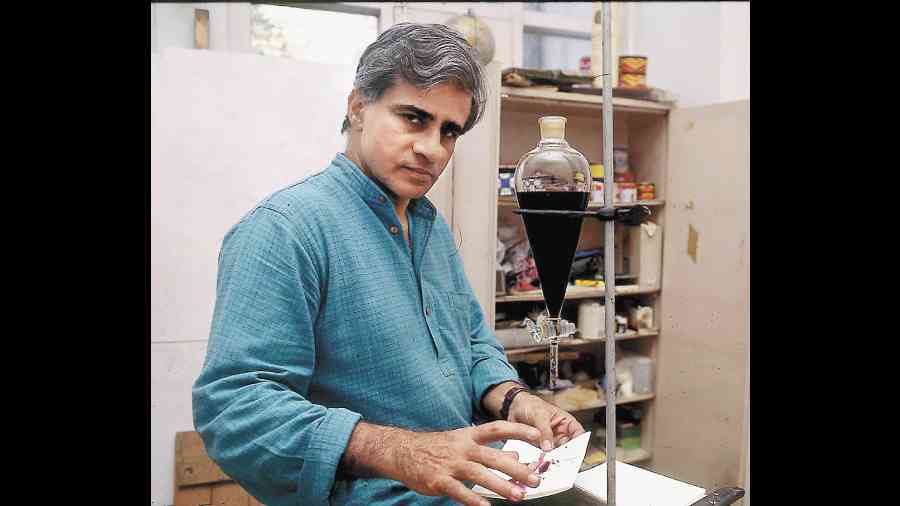I am not competent to discuss the work of Vivan Sundaram, the brilliant painter and installation-artist who passed away on March 29. But I must still write about him because not doing so for a person who has so enriched my life would be utterly invidious.
Vivan and I should have met in 1970. I had gone from Cambridge to London to speak at SOAS to a group of Left students on the Indian political economy, and Vivan later told me that he was in the audience; but we did not meet. Likewise, we were both at the massive and historic Grosvenor Square demonstration in London against the Vietnam War, but we never met in that sea of humanity. Our first meeting was in Delhi after both of us had returned to India. My wife and I had gone to an exhibition of his paintings, including a remarkable one that he had done when his mother had passed away. We asked the person who we thought was the attendant at the show how we could meet the painter; and he shyly informed us that he was the painter.
Vivan was a frequent visitor to the Jawaharlal Nehru University those days, bringing all his exhibitions to the campus, happily talking to students, and socializing with members of the faculty. We often congregated at the house of our close common friend, Anil Bhatti. Our then vice-chancellor, G. Parthasarathy, had a large painting by him on the wall behind his chair in the VC’s office, and there was even some talk of Vivan joining the JNU faculty. But GP’s term got over and the Emergency intervened; nothing came of the proposal about his joining.
He did a series of drawings on the Emergency which he exhibited in JNU and sold to whoever would buy, not only dirt cheap but on a “take now and pay whenever you can” principle. We possess one of these sketches, indeed the last sketch of the series, showing the triumph of the common man, which was later borrowed by Vivan for an exhibition in Germany.
The post-Emergency days were heady. The Left was gaining ground and Vivan, who had become radicalized by the student movement of the late-Sixties that reached its apogee in May 1968, rejoiced along with the rest of us. It was also a period of bold projects. Vivan had done two large paintings as backdrops to the stage for the Jullundur and Vijayawada Party Congresses of the Communist Party of India (Marxist). There was a conference of artists and intellectuals in Vivan’s house in Kasauli in 1979 where he had set up the Kasauli Art Centre that hosted artists regularly for years.
The participants on that occasion included Vivan and Geeta Kapur, the film-maker, Saeed Mirza, the architect, Romi Khosla, the danseuse, Chandralekha, the academics, Anil and Heidi Bhatti, Mihir and Malini Bhattacharya, Madhu Prasad, Kalpana Khosla, G.P. Deshpande, and critics and the theorists, Rajendra Prasad, Sadanand Menon, P. Govinda Pillai, Jennifer Mirza, Sudhi Pradhan, among others, along with a large group of our children. The papers were extraordinarily rich and the discussions were prolonged and intense. The idea of launching a journal was mooted there which soon became a reality in the form of the Journal of Arts and Ideas. The journal could not be sustained for long, but its few issues bear testimony to the ferment of the times and also to the immense talent in the country.
Vivan soon moved away from painting. But he continued to work at a frenetic pace — on installations, photographs, and multi-media presentations; he also curated a photographic exhibition on the Sher-Gill family (Amrita was his mother’s sister). Among his installations, the most memorable for me were the one at the Victoria Memorial, the figure of the Mumbai riot victim, and the work on the Naval Mutiny of 1946 (co-presented with the cultural theorist, Ashish Rajadhyaksha, and the sound artist, David Chapman). Vivan was also actively associated with the Safdar Hashmi Memorial Trust, being one of its founding trustees and curating numerous art exhibitions for it; in this capacity, he was at the forefront of the artistic resistance against the growth of neo-fascism in the country.
Vivan was not just a brilliant artist and a Left activist fighting against the growth of neo-fascism, he was, above all, a remarkable person. Totally free of any guile and posturing, he was staggeringly honest. When he moved Left in his student days at the Slade School of Fine Art, he set up a commune in London along with some friends and plunged into hectic activism that even saw him arrested and thrown into a British prison. Fortunately, the Indian High Commission came to know of his imprisonment and intervened to get him released.
The ferment of the 1960s, culminating in May ’68, had radicalized many students (the term, ‘sixty-eighters’, is often used for them). The Indian students in the West at the time who came back to the country were drawn to the CPI(M) because of its independent stance vis-à-vis both Moscow and Beijing, and the fact that its positions were thought out by itself rather than given from outside. The depth of their conviction was such that they have remained more or less loyal to their original commitment, many even occupying leadership positions within the CPI(M) to this day.
The ‘sixty-eighters’, alas, are now leaving us one by one. It was a brilliant, serious, and thoughtful group that traversed the distance between Jean-Paul Sartre and the Comintern. Vivan Sundaram was a leading member of this group. The world will be much poorer without him.
Prabhat Patnaik is Professor Emeritus, Centre for Economic Studies, Jawaharlal Nehru University, New Delhi











